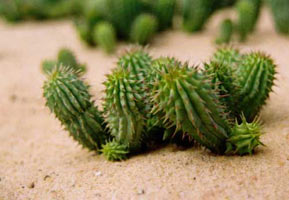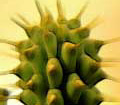
Hoodia (or Hoodia Gordonii) is a South African dwelling plant that the San bushman have used to help endure long hunting expeditiions for generations. Hoodia Gordonii is actually a succulent not to be confused with a cactus. It belongs in the succulent family of Asclepiadaceae along with stapelia, stephanotis and vinca. There are approximately 20 species in the genus of Asclepiadaceae. As it grows it forms stemmed clumps approximately one foot high and bears, pale purple saucer-shaped flowers in shades of red or purple brown. Hoodia Gordonii was discovered and used by the San tribe from the Kalahari, South Africa, since prehistoric times. They chewed the bitter Hoodia plant twice a day to suppress hunger and thirst during long hunting trips. This plant contains the miracle molecule p57 that was recently translated into a obesity cure. Hoodia Gordonii is a leafless spiny succulent plant ( not a cactus ) with fleshly finger-like stems. Rows of thorns are present along the stems, bearing flesh coloured flowers. Hoodia Gordonii grows naturally in the harsh desert conditions of South Africa. Now Hoodia Gordonii has been found in the semi-deserts of Zambia, Zimbabwe, Botswana, Namibia, Angola, the Republic of South Africa, and now found in some other arid regions of South American Nations such as Chili, Peru and some regions of West China including Gansu, Sichuan and Shanxi.
Independent tests conducted in Leicester, England on obese individuals from all walks of life have proved that over a 15-day period, food intake was reduced by 1000 calories a day. Mass global interest has been shown for Hoodia since Pfizer, the international pharmaceutical giant, started to research Hoodia's potential to help people with obesity. Pfizer recently discovered Hoodia and decided to invest millions into researching the plants benefits as a new drug that would help with obesity. The research published by this company has catapulted Hoodia into the international spotlight. Laboratory experiments show animals automatically restrict their food intake when taking hoodia orally. Rats, a species that will eat anything from meat and plants to indigestible fiber, lowered their dietary calorie intake to a degree that made them get thin when fed comparative amounts of hoodia.
In the wild Hoodia takes 5-6 years to mature but is now being cultivated in as little as 2 years commercially in sustainable quantities and has become widely known for its effects as an appetite suppressant. The Hoodia Gordonii plant originated in the southwestern part of Africa and grows best in the semi-arid areas of South Africa primarily the Kalahari. In its native habitat it is extremely difficulty to identify because it looks similar to succulents of the same family of which there are many. Only an experienced botanist or as the case in South Africa with Hoodia Gordonii a San people can identify the plant prior to it's blooming.
It basically tricks the brain into thinking that you're full. The chemical constituents in Hoodia work within the satiety center by releasing a chemical compound similar to glucose but much stronger. The hypothalamus in the brain receives this signal as an indication that enough food has been consumed and this in turn stunts the appetite. Hoodia helps to curb your appetite, some has reported, suppressing appetite within 20-30 minutes after taking Hoodia, results may vary. Some may need a little more time than this before they begin to notice the effects like: A reduced interest in food and A delay in time after eating before hunger sets in. We all know, if you don't feel hungry, you will eat less. Using Hoodia along with a sensible diet and exercise can help make your weight loss efforts much more successful! Pure Hoodia is 100% All Natural. Hoodia is not a drug. If you buy the right kind it will work. You will eat less, feel full, not be hungry as often, and lose weight. Every clinical case has shown people have been able to reduce their calorie intake by 900 to 1,100 calories daily. This is enough for most people to lose a pound every three-four days. When you eat hoodia, the saying goes, your hunger will simply be gone -- gone -- for around six hours. During those six hours, you won't crave anything. You really won't want to eat at all. The food still smells good, as usual, and they taste the same if you eat them, but you don't want to eat them! At least that's what the hoodia advocates claim will happen. To understand how all this works, you have to understand what "hunger" really is in the first place. Hunger is just an illusion. It's a signal in your brain, a chemical message that causes you to feel certain feelings and, ultimately, act on them. Your body creates the illusion of hunger even when you're not really needing calories. And your body, like mine, doesn't know when to turn it off. The hunger signal is only turned off when your hypothalamus thinks you've eaten enough food. Your hypothalamus -- part of your body's endocrine system -- decides this by sensing the rise of sugar (glucose) in your blood. Eat enough carbohydrates, and your blood sugar rises, which convinces your hypothalamus to tell your brain that you're no longer hungry. Consuming hoodia is surprisingly simple: slice off a piece of the succulent, peel off the thorns, and just start chewing on it. You don't even need to swallow it. The taste is rather bitter by most Americans' palettes, but after several minutes of chewing, you've already started absorbing the chemical. Guess what? Your hunger is vanishing with each passing moment.
The pure Hoodia that contains appetite suppressant qualities is only grown in one specific region in South Africa. If the Hoodia is from China, USA or any other part of the world and is not accompanied by a South African Government Certificate of Authenticity, the product is inferior and ineffective. Hoodia is also known by horticulture experts as being extremely difficult to cultivate in captivity. The plants rot easily, and they won't grow in regular soil -- they need sandy soil with excellent drainage. Also, to make things even more difficult, these plants aren't pollinated by bees, they're pollinated by flies. To attract the flies, their blooms emit a strong, repulsive odor that smells a lot like rotting flesh. So buying hoodia is very difficult. It's expensive. And, naturally, there are a lot of fakes on the market. Even now, there are only a few hundred acres of hoodia growing on commercial farms, and the plant is highly susceptible to being wiped out by rather mysterious conditions.
The Hoodia is an all-natural, herbal dietary supplement and there are no know adverse side effects relating to its use. No Caffeine. No Ephedra. So Hoodia is safe for us. Hoodia was eaten as a fresh food by the San tribe for thousands of years with zero side effects. As far as scientists know, there are no negative side-effects. The local san, whose ancestors have been using the plant for thousands of years, claim that there are no negative side effects. So Hoodia can be used in conjunction with prescription medications. The quickness and degree of results will vary depending on the frequency of use and other factors. However, you should start to see the beginning of the weight loss process within two weeks. Please note that the same as with any weight loss supplement, better results will be realized when taken in conjunction with a healthy diet and reasonable exercise.

|